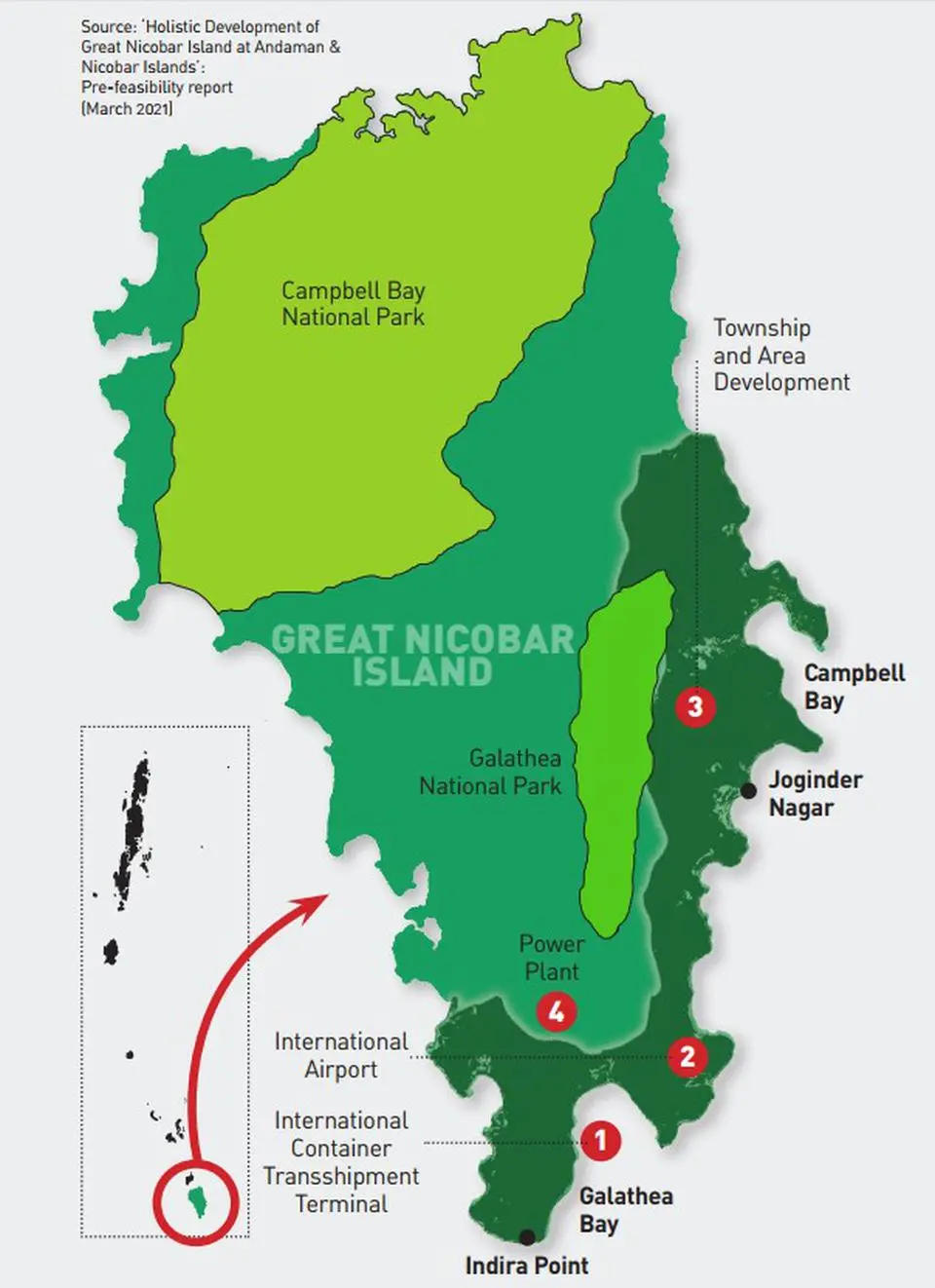Context
-
Great Nicobar Island (GNI), situated at the end of the Andaman and Nicobar archipelago, is in peril.
-
If the proposed plans for an international container transshipment terminal, power plant, township area, and international airport, as part of the large-scale development project put forth by NITI Aayog and the Andaman and Nicobar Islands Integrated Development Corporation Limited, materialise, the landscape, along with its unique people and flora and fauna, will change irreversibly.
Impact of the development project to flora and fauna
- Habitat alterations can increase human-wildlife conflict, adversely affecting the populations and health of the animals and leaving them vulnerable to fatal injuries from territorial fights.
Photo Credit: Aashish Gokhale - Exposed to harmful effects of development like pollution and loss of shelter and natural food sources and become more dependent on human food.
- As vast stretches of forests from Galathea Bay and the GNI UNESCO Biosphere Reserve are proposed to be chopped down to make way for new roads and infrastructure, the historically invaluable habitats of birds face destruction.
- If expansive swathes of these littoral mangroves are lost, the island will become more vulnerable to natural disasters.
- There will also be considerable loss of the coral reefs along the island’s coastline with the planned constructions claiming over 298 hectares of the adjoining sea bed.
- GNI will see a rapid decline in marine biodiversity.
- The construction of an international terminal along the turtles’ prime nesting habitat will pose severe challenges to their survival. Sustained coastal disturbances could permanently deter sea turtles from using the island for breeding in the future.
- An estimated 8,52,245 trees are to be cut down in GNI’s prehistoric rainforests. This has given rise to serious concern among academics, wildlife conservationists, and human welfare activists.



Flora and fauna of Great Nicobar Island
Nicobar long-tailed macaque
- The largest mammal on the island is the Nicobar long-tailed macaque ( Macaca fascicularis umbrosa), a vulnerable subspecies of the larger family of long-tailed macaques found across South-East Asia.
- This particular subspecies is distinct from its cousins in appearance, behaviour and geographical location.
- The macaque is found on only three of the Nicobar islands—Katchal, Little Nicobar, and Great Nicobar—with GNI being home to the largest population.
- The primates have adapted to island life perfectly and make use of rainforests, coastal habitats, and mangroves alike.
- Their staple is the endemic screwpine species, Pandanus fascicularis, which is also the staple of the indigenous Nicobarese communities of these islands.
- People and monkeys share living space and compete for resources in Campbell Bay and other rural areas along the south-eastern strip of the island.
Nicobar megapode ( Megapodius nicobariensis)
- A medium-sized scrubfowl species found only in a few Nicobar islands. Their largest population is in GNI. The Nicobar megapode is unlike any other bird in having a fascinating reproductive biology. Known as “temperature birds” locally, they collect soil, sand, leaf litter, and other debris from coastal forests to build “mounds”, which can be up to four-feet high, to hold their eggs until they are ready to hatch. Two or three pairs of megapodes maintain the mounds, ensuring that the eggs remain at the perfect temperature inside the soil.
Other important flora and fauna
- GNI has a coastline of 202 km, most of which is lined by mangrove communities which grow in clusters, including the endemic Pandanus (screwpine).
- GNI is currently a sea turtle nesting hotspot.
- The forests are home to rare flora and fauna, including the Nicobar crested serpent eagle, the Nicobar pigeon, the Nicobar treeshrew, the Nicobar sparrowhawk, the Andaman crested serpent eagle, the Nicobar imperial pigeon, and many more.
Way Forward
- An EIA report from 2022, conducted by a Hyderabad-based laboratory, put forth superficial mitigation plans to offset the destruction caused by the project. These consisted of suggestions to translocate the macaques to surrounding islands, planting more trees, and designating areas for turtle nesting. The schemes are not only inadequate but also likely to have unintended consequences in the areas where they are attempted.
- In the absence of clear protocols or funding for the mitigation measures, they sound unconvincing.
- On GNI, about 8,000 people (its population) and an incredibly diverse flora and fauna are packed into a tiny space brimming with potential—for learning, growth, and responsible development that benefits the inhabitants instead of harming them. This potential should not be abused. Rather, it should be valued and preserved carefully.
Source: Frontline
Visit Abhiyan PEDIA (One of the Most Followed / Recommended) for UPSC Revisions: Click Here
IAS Abhiyan is now on Telegram: Click on the Below link to Join our Channels to stay Updated
IAS Abhiyan Official: Click Here to Join
For UPSC Mains Value Edition (Facts, Quotes, Best Practices, Case Studies): Click Here to Join
